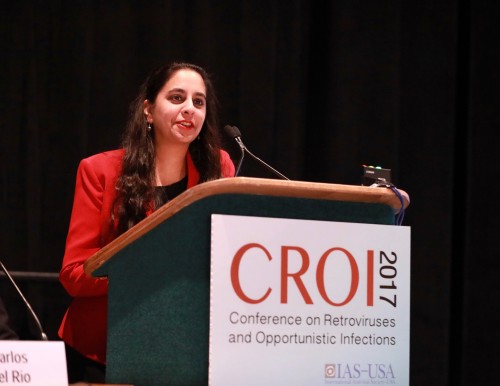Eight states saw quite a steep decline in estimated HIV transmission rates as the national rate fell 18 percent between 2008 and 2014, Medscape reports.
At the 2017 Conference on Retroviruses and Opportunistic Infections (CROI) in Seattle in February, Centers for Disease Control and Prevention researchers reported on the declining national rate. The CDC’s Sonia Singh, PhD, also provided companion data on the estimated HIV incidence (yearly number of new transmissions), HIV prevalence (number of people living with the virus) and proportion of the HIV population that is undiagnosed for 33 states and the District of Columbia (those jurisdictions about which there is adequate surveillance data to conduct such analyses).

Sonia Singh of CDC at CROI 2017 in SeattleBenjamin Ryan
The HIV incidence remained essentially flat in 28 states, including high-prevalence states such as Florida, which has not had a particularly robust public health response to the epidemic. An additional 15 states did not have enough cases of the virus to properly analyze incidence trends. In eight remaining states and districts, the HIV incidence rate declined annually by the following factors between 2008 and 2014 (compared with a 3.6 percent annual decline nationally): DC, 10 percent; Maryland, 7.5 percent; Pennsylvania, 7.3 percent; Georgia, 6.1 percent; New York, 5.1 percent; North Carolina, 4.9 percent; Illinois, 4.3 percent; and Texas, 2.4 percent.
With people with HIV living longer, the prevalence of HIV increased nationally and in 23 states.
The proportion of the HIV population that was undiagnosed dropped 3.4 percent annually between 2008 and 2014 and in all states for which there were enough people living with the virus for the researchers to conduct the analysis. This included the following annual declines: Pennsylvania, 7.9 percent; Georgia, 6.1 percent; Louisiana, 5.3 percent; Illinois, 5 percent, Maryland, 4.3 percent; Texas, 3.8 percent; California, 2.6 percent; and Ohio, 0.8 percent.
To read the Medscape article, click here (free registration with the site is required).
To read the conference abstract, click here.







1 Comment
1 Comment